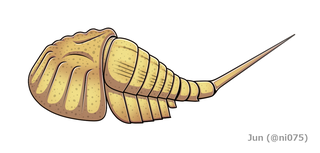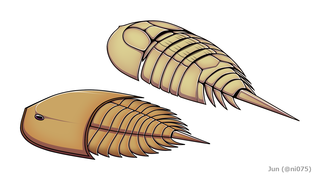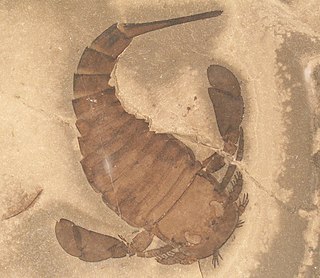
Chasmataspidids, sometime referred to as chasmataspids, are a group of extinct chelicerate arthropods that form the order Chasmataspidida. Chasmataspidids are probably related to horseshoe crabs (Xiphosura) and/or sea scorpions (Eurypterida), with more recent studies suggest that they form a clade (Dekatriata) with Eurypterida and Arachnida. Chasmataspidids are known sporadically in the fossil record through to the mid-Devonian, with possible evidence suggesting that they were also present during the late Cambrian. Chasmataspidids are most easily recognised by having an opisthosoma divided into a wide forepart (preabdomen) and a narrow hindpart (postabdomen) each comprising 4 and 9 segments respectively. There is some debate about whether they form a natural group.

Bembicosoma is a genus of synziphosurine, a paraphyletic group of fossil chelicerate arthropods. Bembicosoma was regarded as part of the clade Planaterga. Fossils of the single and type species, B. pomphicus, have been discovered in deposits of the Silurian period in the Pentland Hills, Scotland. Bembicosoma had been tentatively assigned as an eurypterid before its synziphosurine affinities revealed.

Bunodes is a genus of synziphosurine, a paraphyletic group of fossil chelicerate arthropods. Bunodes was regarded as part of the clade Planaterga. Fossils of the single and type species, B. lunula, have been discovered in deposits of the Silurian period in Ludlow, England. Bunodes is the type genus of the family Bunodidae, the other genera of the same family being Limuloides.

Cyamocephalus is a genus of synziphosurine, a paraphyletic group of fossil chelicerate arthropods. Cyamocephalus was regarded as part of the clade Planaterga. Fossils of the single and type species, C. loganensis, have been discovered in deposits of the Silurian period in Lesmahagow, Scotland. Cyamocephalus is one of the two members of the family Pseudoniscidae, the other being Pseudoniscus. Cyamocephalus differ from Pseudoniscus by the fused tergites of 6th and 7th opisthosomal segments.

Legrandella is a genus of synziphosurine, a paraphyletic group of fossil chelicerate arthropods. Legrandella was regarded as part of the clade Prosomapoda. Fossils of the single and type species, L. lombardii, have been discovered in deposits of the Devonian period in Cochabamba, Bolivia.

Limuloides is a genus of synziphosurine, a paraphyletic group of fossil chelicerate arthropods. Limuloides was regarded as part of the clade Planaterga. Fossils of the genus have been discovered in deposits of the Silurian period in the United Kingdom and potentially in the United States. Limuloides is one of the two genera of the family Bunodidae, the other being the type genus Bunodes. Limuloides is characterized by a carapace with radiated ridges and serrated lateral regions, and an opisthosoma with rows of nodes. Limuloides was once though to have lateral compound eyes on its carapace, but later investigation did not find any evidence of it.

Pasternakevia is a genus of synziphosurine, a paraphyletic group of fossil chelicerate arthropods. Pasternakevia was regarded as part of the clade Planaterga. Fossils of the single and type species, P. podolica, have been discovered in deposits of the Silurian period in Podolia, Ukraine.

Pseudoniscus is a genus of synziphosurine, a paraphyletic group of fossil chelicerate arthropods. Pseudoniscus was regarded as part of the clade Planaterga. Fossils of the genus have been discovered in deposits of the Silurian period in the United Kingdom, the United States and Estonia. Pseudoniscus is one of the two members of the family Pseudoniscidae, the other being Cyamocephalus.

Weinbergina is a genus of synziphosurine, a paraphyletic group of fossil chelicerate arthropods. Fossils of the single and type species, W. opitzi, have been discovered in deposits of the Devonian period in the Hunsrück Slate, Germany.

Synziphosurina is a paraphyletic group of chelicerate arthropods previously thought to be basal horseshoe crabs (Xiphosura). It was later identified as a grade composed of various basal euchelicerates, eventually excluded form the monophyletic Xiphosura sensu stricto and only regarded as horseshoe crabs under a broader sense. Synziphosurines survived at least since early Ordovician to early Carboniferous in ages, with most species are known from the in-between Silurian strata.

Pseudoniscidae is an extinct family of synziphosurine chelicerates that lived in the Silurian. Pseudoniscidae is classified inside the clade Planaterga, alongside Bunodidae and Dekatriata. Pseudoniscidae is composed by two genera, Cyamocephalus and Pseudoniscus.

Wiedopterus is a genus of eurypterid, an extinct group of aquatic arthropods. The type and only species of Wiedopterus, W. noctua, is known from deposits of Early Devonian age in Germany. The generic name derives from the Wied river, which runs near the site of the initial discovery, and the species name, noctua, derives from Latin noctua (owl) which refers to the superficial resemblance of the carapace to an owl.

Borchgrevinkium is an extinct genus of chelicerate arthropod. A fossil of the single and type species, B. taimyrensis, has been discovered in deposits of the Early Devonian period in the Krasnoyarsk Krai, Siberia, Russia. The name of the genus honors Carsten Borchgrevink, an Anglo-Norwegian explorer who participated in many expeditions to Antarctica. Borchgrevinkium represents a poorly known genus whose affinities are uncertain.

The metastoma is a ventral single plate located in the opisthosoma of non-arachnid dekatriatan chelicerates such as eurypterids, chasmataspidids and the genus Houia. The metastoma located between the base of 6th prosomal appendage pair and may had functioned as part of the animal's feeding structures. It most likely represented a fused appendage pair originated from somite 7, thus homologous to the chilaria of horseshoe crab and 4th walking leg pair of sea spider. In eurypterids, the plate was typically cordate (heart-shaped) in shape, though differed in shape in some genera, such as Megalograptus.

Dekatriata is a clade of planatergan chelicerates including the groups Arachnida, Chasmataspidida, Eurypterida and additionally two stem-genera Winneshiekia and Houia. Dekatriata is defined by an opisthosoma with 13 segments as groundplan and fused, plate-like appendages on the first opisthosomal segment.

Planaterga is a clade of prosomapod euchelicerates including several synziphosurid genera and the group Dekatriata. Planaterga is defined by the opisthosoma with tergites broadest at third or fourth and lacking enlarged axial nodes, carapace with reduced genal spines, as well as somite VII with reduced appendages and microtergite.

Houia is an extinct genus of dekatriatan, a clade of chelicerate arthropods. Fossils of Houia have been discovered in deposits of the Early Devonian period in Guangxi and Yunnan, both in China. The genus contains two species: H. guangxiensis, from the Pragian to Emsian epoch of Guangxi; and H. yueya, the type species, from the Lochkovian epoch of Yunnan. The name of the genus is derived from the Chinese character 鲎 (hòu), meaning "horseshoe crab".

Venustulus is a genus of synziphosurine, a paraphyletic group of fossil chelicerate arthropods. Venustulus was regarded as part of the clade Prosomapoda. Fossils of the single and type species, V. waukeshaensis, have been discovered in deposits of the Silurian period in Wisconsin, in the United States. Venustulus is one of the few synziphosurine genera with fossil showing evidence of appendages, the other ones being Weinbergina, Anderella and Camanchia. Despite often being aligned close to horseshoe crabs, it has been found that Venustulus and its relatives form a group made up of various basal euchelicerate arthropods more distant to the xiphosurans.

Camanchia is a genus of synziphosurine, a paraphyletic group of fossil chelicerate arthropods. Camanchia was regarded as part of the clade Prosomapoda. Fossils of the single and type species, C. grovensis, have been discovered in deposits of the Silurian period in Iowa, in the United States. Alongside Venustulus, Camanchia is one of the only Silurian synziphosurine with fossil showing evidence of appendages.

Anderella is a genus of synziphosurine, a paraphyletic group of fossil chelicerate arthropods. Anderella was regarded as part of the clade Prosomapoda. Fossils of the single and type species, A. parva, have been discovered in deposits of the Carboniferous period in Montana, in the United States. Anderella is the first and so far the only Carboniferous synziphosurine being described, making it the youngest member of synziphosurines. Anderella is also one of the few synziphosurine genera with fossil showing evidence of appendages, but the details are obscure due to their poor preservation.





















